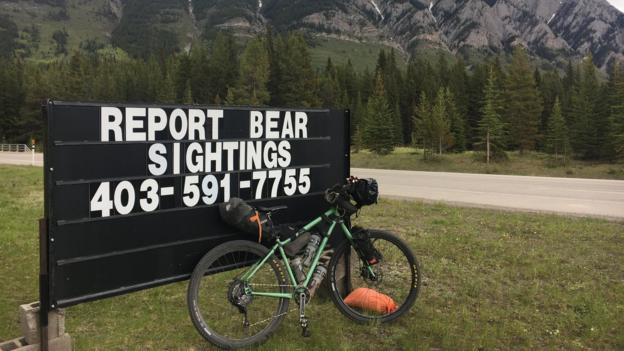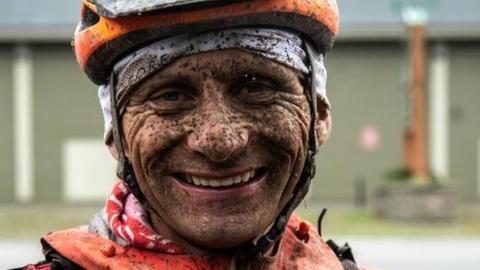
“You experience enough things in that one race that could do you a lifetime.”
The Tour Divide cycling race is quite like no other. Riding unassisted for 4,400km, from Canada to Mexico over some of the most rugged and tough terrain, it is the ultimate test of man, mind and machine.
Four seasons in a day, avoiding America’s wildlife and the equivalent of climbing Mount Everest six times. The race through the USA has everything.
Northern Ireland’s Davy Patterson is one man who embarked on this 21-day adventure, which is guided by GPS through the Rocky Mountains.
“Nobody really knows or meets the race organiser. You send $80 to a PO Box and receive a spot tracker,” he said.
“You stick that on your bike and you meet for an 8am start in Banff, in Alberta, Canada.
“There are 180 of us at the start, but no-one to flag us off. We just all set off until we reach the Mexican border.”
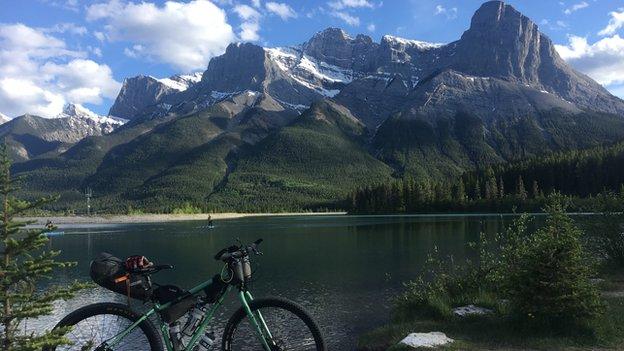
A big allure of the Tour Divide is that you have to be self-reliant along the route, with rules stating you are not allowed to meet anyone you know along the way, or have food packages or spares dropped off.
“If there is a bike shop, motel, store or restaurant that you pass, you can use them but that’s it,” added Patterson.
“The rules are that you don’t accept support, you follow the course and that you aren’t rude to anyone along the way.
“It’s pretty remarkable and it is so far removed from the rules and regulations that are tied in with commercial sport.”
Failure to finish drove me on
The Straid man works in the production side of the World Rally Championship and also takes part in cycling tours, including from Marrakesh to the Sahara.
His parents were involved with motorsport and older brother Chris has navigated at WRC level. Adventure and travel are in his DNA.
In fact, it was five-time WRC rally winner Kris Meeke who pointed the Tour out to Patterson and planted the seed in the mind of his compatriot.
“Kris sent me a picture of it and after a bit of research I wanted to give it a go,” said the former motorcycle racer and rally driver.
“I’m not a young man, I’m nearly 50 years old, but I thought the endurance style of racing would suit me.”
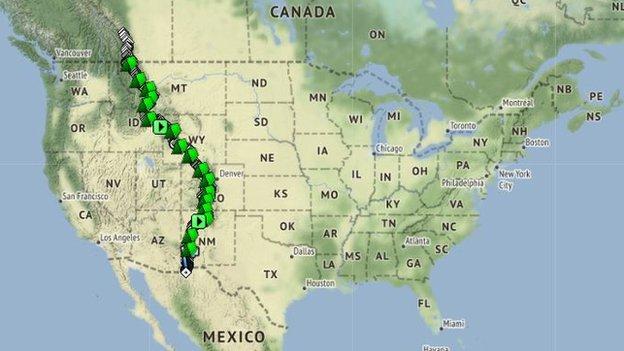
His first attempt was in June 2018, however a hip injury in the early stages of the race forced him to pull out.
“It was an old injury from when I raced motorbikes,” he added.
“I had quite a big job of getting myself out of the race because I had to try and get home from the Whitefish Mountains.
“There’s no rescue or backup service, no one is going to check up on you.
“The first year wasn’t successful, but that made me more determined.”
Living the dream
One year on, Patterson returned to Canada to try and conquer the intimidating event.
Roughly 85% of the route is off-road and competitors use an adapted mountain bike which can hold luggage.
“You’re talking mountain routes, forests, single tracks and even some deserts to cross,” added Patterson.
“You’re doing anything from 12-16 hours riding each day, averaging around 200-250km.
“There are some places where the terrain is too rough or snowy to ride, so you have to push or carry your bike.
“All the climbing combined throughout the race is climbing Mount Everest six times over from sea level.”
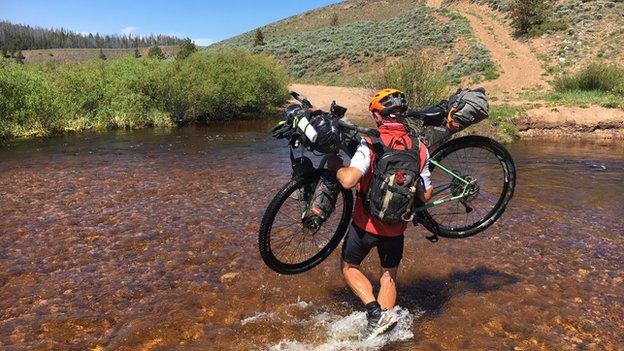
As you route takes competitors through rural routes, Patterson says the race includes some “amazing areas” of backcountry America.
“Some of the people in these villages have seen the race coming for 15 or 20 years, so they know when to expect the riders,” he said.
“You get to see and meet some incredible places and people.
“It’s so different from the ‘regular visits’ that people have to the USA.”

While the physical demands were arduous, Patterson says a positive mindset is just as important when undertaking the ‘bikepacking’ event.
“I’d done a lot of cycling alone in some remote places, so I was prepared mentally,” he said.
“You just try not to have any negative doubts or thoughts.
“You’re physically tired, but I was happy to be out living the dream.
“There are quite a few people who stop because they can’t handle it mentally.
The distances, the terrain, the concept of being far from rescue, help or people, it can all be overwhelming.”
“It is tough and from the 180 that started, only 60 or so actually finished.”
Grizzly bears and four seasons in a day
As with any extreme sport, dangers lurks from many angles in the Tour Divide, however unlike most adventures, encounters with dangerous animals are a realistic prospect.
“There is a stretch called Grizzly Bear Highway. Some bears had intruded into human habitat and tried some human food,” revealed the 49-year-old.
“They are considered dangerous bears because they will always follow human food and human scent.
“They are often moved to remote areas, but that just happens to be where the race goes through and where some people camp.
“There are some dangerous spiders, dangerous snakes, you get elks and moose.
“I woke up one morning and my sleeping bag was surrounded by scorpions, which certainly got me up and riding pretty quickly.”
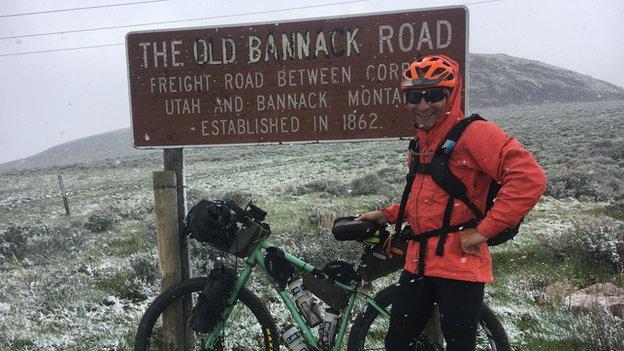
Despite the presence of animals, Patterson feels the “huge variants” in the weather are the biggest obstacle in the race.
“Even though it is in July, you can reach minus eight degrees in the mountains,” added Patterson. “In the same day you could end up riding in the desert in 40-degree heat.
“There are some traffic in some places, like farming or logging trucks. You go through places where there are drug problems, so there is the risk of people.
“There have been injuries and fatalities, and the risk is compounded by the fact there are no medical services on site. You’re far from help in a lot of places.”
A fence in the desert
After coming to the finish at a remote border post in New Mexico, you would think there would be some sort of grandeur after completing one of the most difficult races in the world. However, that is far from reality.
“There’s no ceremony or anything. There’s no one there to meet you. It’s just a fence in the middle of the desert,” said Patterson, who finished the race in an impressive 22 days, 20 hours and 45 minutes.
“You touch the fence and the organisers can see electronically that you are there.
“It’s strange, because your main emotion while going down the final stretch of road is wondering how you will get home.
“I finished 24th and you feel a huge amount of respect for those who have already finished, and for those who have yet to come.
“When I actually got to the fence there wasn’t a huge amount of emotion. You leave most of your emotion in the mountains and in the desert.”
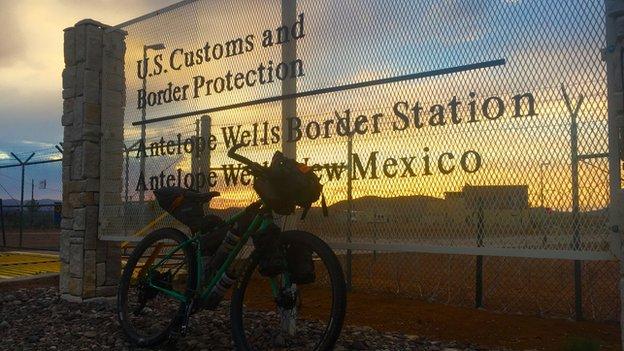
While thinking about how to get home may seem like a glamorous metaphor for missing his native Northern Ireland, Patterson’s remarks are rather literal.
As competitors don’t know how many days it will take them to finish the race, if at all, transport home isn’t arranged until the end of their journey.
“A local guy gave me a lift to a small town in the back of an old Volvo, and I made my arrangements to get home from a motel,” Patterson said.
He also adds that the achievement didn’t sink in until he was back in the World Rally paddock in Finland and was congratulated by several leading drivers including Meeke, Craig Breen and Elfyn Evans.
“When I got back to work at the next rally, a few of the drivers were mentioning it to me and that’s when it hit home what I had done,” he said.
“I knew it was a great thing to achieve, but I think the scale of it had started to sink in.
“I would love to do it again, expect maybe with a single speed bike without gears to take it to another dimension of difficulty.
“It is the adventure of a lifetime.”
